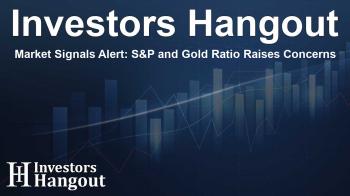Market Signals Alert: S&P and Gold Ratio Raises Concerns

Understanding the Current Market Dynamics
The U.S. equities market is experiencing significant highs, yet several underlying fundamental and technical indicators suggest potential trouble ahead. For starters, there's been an alarming increase in bankruptcy filings shown by 446 large companies that have faced collapse recently. Alongside this, market breadth has diminished, prompting concerns reminiscent of prior economic downturns.
Examining market valuations reveals a striking reality, with Robert Shiller's CAPE ratio approaching levels seen during the dot-com bubble, and Warren Buffett's gauge of market capitalization relative to GDP signaling caution. Together, these factors create an environment ripe for volatility.
Examining the S&P 500-to-Gold Ratio
The Growing Caution in Equity Markets
The S&P 500-to-Gold ratio presents the latest warning signal, as identified by Danish economist Henrik Zeberg, an analyst well-versed in long-term market cycles. His insights suggest that we may be in the midst of a generational warning; one that indicates potential upheavals in financial markets.
This specific ratio has historically foreshadowed significant market corrections, having only indicated reversals three times over the last century: during 1929, 1971, and 2000. Each of these events marked pivotal moments in financial history, leading to the Great Depression, the end of the gold standard, and the bursting of the dot-com bubble, respectively.
Indicators and Their Significance
Technical analysis reinforces Zeberg's concerns. In his recent publication, he pointed out critical indicators like the RSI and MACD, which have crossed lower for the S&P/Gold ratio, marking only the fourth occurrence in history. This crossover typically signals a change in market cycles, suggesting that gold could significantly outperform equities in the coming years, just as it did following the 1929 stock market crash.
In those defining moments, the S&P/Gold ratio saw a sharp decline, often signifying a transition to a period where gold became the preferred asset as equities faltered. For instance, after 1971, when the U.S. moved away from the gold standard, commodities surged and gold maintained an upward trajectory. Similarly, the early 2000s showcased a prolonged bull market for gold amidst stagnating stock prices, following the tech boom bust.
Current Economic Conditions
Potential Risk Factors
The prevailing macroeconomic conditions echo those inflection points in history. Currently, corporate defaults have gained pace, dwindling market breadth is becoming apparent, and even key figures in technology sectors are acknowledging a speculative bubble may be forming. According to Zeberg, these elements create an environment akin to a 'deflationary bust', where traditional assets might stumble due to overwhelming debt levels, while gold could emerge as a quiet victor.
The dynamics of the U.S. dollar also play a critical role in these developments. If Zeberg's analysis holds true, an appreciating dollar could exacerbate existing market pressures. This perspective aligns closely with the well-documented notion of a dollar's propensity to strengthen during global economic slowdowns. Historical patterns indicate that economic downturns often coincide with spikes in the U.S. dollar value.
Market Implications
A robust dollar exerts pressure on emerging markets, global trade, and commodities in the immediate term. Thus, understanding the S&P/Gold ratio becomes essential; it filters out the market noise caused by currency fluctuations and highlights which asset classes genuinely retain their value amidst financial turmoil.
As history suggests, when the S&P-to-Gold ratio experiences a breakdown, it may reflect gold's emerging dominance—not due to explosive performance, but rather as investor confidence in equities wanes. Analysts anticipate that similar patterns could unfold as we progress into uncertain economic terrain.
Frequently Asked Questions
What does the S&P-to-Gold ratio indicate?
The S&P-to-Gold ratio is a market indicator suggesting potential shifts in economic conditions, particularly when signaling reversals as observed historically during major downturns.
Why are bankruptcy filings on the rise?
Increased bankruptcy filings may stem from economic pressures, often exacerbated by debt levels and market corrections leading to unsustainable business operations.
How does the dollar influence equities?
The U.S. dollar often strengthens during periods of economic crisis, putting pressure on equities and creating a strong environment for alternative assets like gold.
What are the historical instances of the S&P-to-Gold ratio indicating reversals?
Historically, significant shifts in the S&P-to-Gold ratio have occurred in 1929, 1971, and 2000, marking periods of economic transition.
How can investors prepare for potential market shifts?
Investors can prepare by closely monitoring market indicators like the S&P-to-Gold ratio and considering diversifying their portfolios with assets that may hold value during downturns, such as gold.
About The Author
Contact Dylan Bailey privately here. Or send an email with ATTN: Dylan Bailey as the subject to contact@investorshangout.com.
About Investors Hangout
Investors Hangout is a leading online stock forum for financial discussion and learning, offering a wide range of free tools and resources. It draws in traders of all levels, who exchange market knowledge, investigate trading tactics, and keep an eye on industry developments in real time. Featuring financial articles, stock message boards, quotes, charts, company profiles, and live news updates. Through cooperative learning and a wealth of informational resources, it helps users from novices creating their first portfolios to experts honing their techniques. Join Investors Hangout today: https://investorshangout.com/
The content of this article is based on factual, publicly available information and does not represent legal, financial, or investment advice. Investors Hangout does not offer financial advice, and the author is not a licensed financial advisor. Consult a qualified advisor before making any financial or investment decisions based on this article. This article should not be considered advice to purchase, sell, or hold any securities or other investments. If any of the material provided here is inaccurate, please contact us for corrections.

